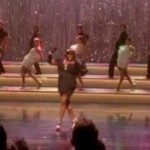In the recent New Yorker, Adam Gopnick comments on “The Forty-Year Itch,” that “prime site of nostalgia” invoked by 40-something Hollywood suits fascinated by “the Edenic period preceding the fallen state” of their lives. Last night’s episode of Glee is a textbook example from 46-year-old series creator Ryan Murphy. “Saturday Night Glee-ver,” written by veteran gleek Matthew Hodgson, is the second film tribute of the series; the first honored the iconic 1970s movie The Rocky Horror Picture Show. In contrast to Smash, there is a surfeit of music here, and last night’s episode covered nearly the entire Saturday Night Fever
soundtrack.
The standout number was “Boogie Shoes,” led by Wade (Alex Newell, runner-up on The Glee Project). As with most disco songs, the lyrics are little more than musical foreplay, but Newell transforms the song into a statement of personal strength akin to “I Will Survive.” The other performances in the show paled in comparison. Director Bradley Buecker over-compensated for the static “How Deep Is Your Love” from Rachel (Lea Michele) and “More Than a Woman” from Finn (Cory Monteith) by constantly panning the camera, while “If I Can’t Have You” from Santana (Naya Rivera) and the “Stayin’ Alive” finale from the cast came off as bland as their white polyester. The songs sounded authentic – perhaps too much authentic falsetto – but the characters never owned them.
In television, most numbers are “program songs” inserted into the story. In theater, most numbers are “character songs” that arise from the story. It’s the classic dichotomy between Dionysian show-stopping razzle-dazzle and Apollonian dramatic progression. Some numbers are a fusion of both, though. For example, “Wilkommen” from Cabaret and “So Long, Farewell” from The Sound of Music
are program songs, that is, songs presented as performed songs, that also provide insight into their characters or the themes of their shows.
What allowed “Boogie Shoes” to work as a show-stopping song and a plot song was its connection to its character and, subsequently, to his story. A telling example of the desire but failure to do the same with “If I Can’t Have You” was Santana’s explanation of her performance immediately afterward. If the number had been able to serve as a character song, such a bald explanation of its plot and subplot elements would be unnecessary; however, the number’s fatal flaw was that it had no razzle and little dazzle.

